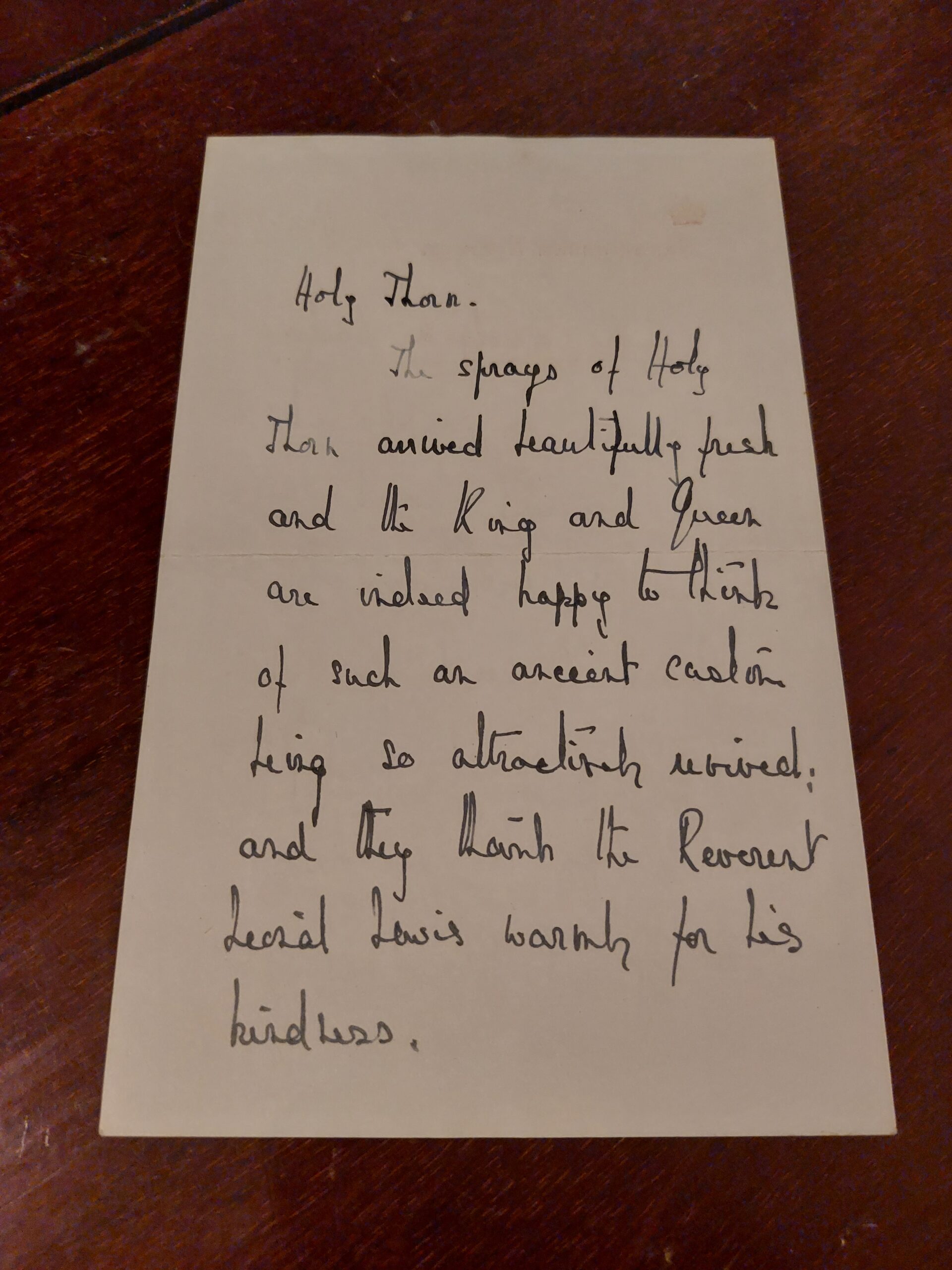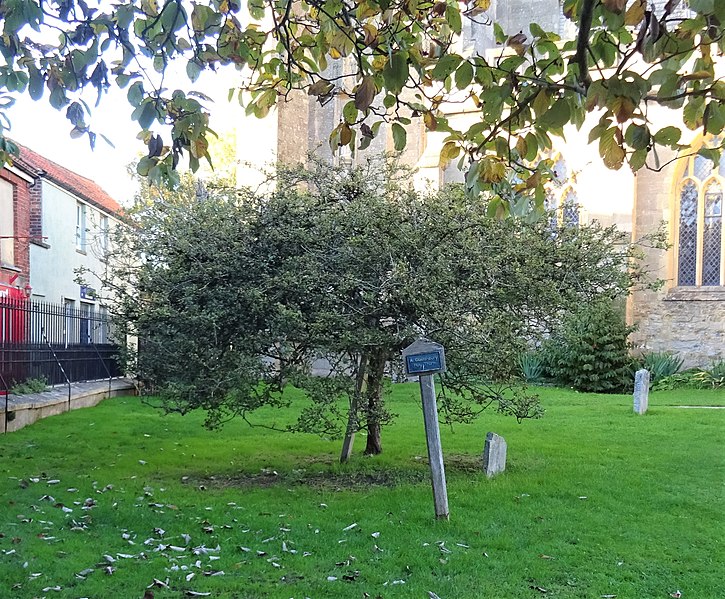Every year, a few days before Christmas, the late queen’s page would walk into Her Majesty’s sitting room carrying a small crystal vase and say, ‘The Glastonbury Thorn Your Majesty.’ He would then place it where the queen could see it. It was one of the Christmas traditions that the queen enjoyed and she was always pleased to see it and know the meaning behind it. Now, of course, sprigs will shortly be on their way to Their Majesties.
An ancient legend has it that Joseph of Arimathea arrived in Glastonbury carrying the Holy Grail. He stuck his staff in the ground at Wearyall Hill, where it grew into the original Glastonbury thorn tree. There is, of course, a dispute over whether or not Joseph came to Glastonbury. The earliest record of Christianity in England makes no mention of him, and the first written account of Joseph’s arrival only dates from the 13th century.
The thorn itself was first written about in 1520, when Richard Pynson published his Lyfe of Joseph of Armathie. Probably commissioned by the Abbot of Glastonbury Abbey, it talks about the unusual thorn which flowers in winter, along with a walnut tree in the grounds of the abbey, that supposedly flowered on midsummer’s day. It was said that these miraculous trees were proof that Glastonbury was the ‘holyest erth of Englande,’ upon which divine favour was bestowed.

Glastonbury Abbey was one of the most important religious houses in the country, containing, so it was said, the tomb of King Arthur and Queen Guinevere. The abbey was dissolved during the English Reformation in 1539, with most of the buildings demolished later, during the reign of Queen Elizabeth I. Nonetheless, the holy thorn still flowered at Christmas and was seen by Roman Catholics as a ‘Testimony to religion, that it might flourish in persecution.’
Both King James I and his son, Charles I, were less suspicious of their Roman Catholic subjects than Elizabeth I had been, (although James may have had a little more cause for suspicion after the Catholic led Gunpowder Plot of 1605). Both kings were fascinated by the strange thorn that flowered at Christmas. Between 1606–16, James Montagu, bishop of Bath and Wells, produced what he called ‘Panegiricall Entertainment’ for the wife of King James, Anne of Denmark. In it, an actor portraying Joseph of Arimathea offered branches of both the thorn and the midsummer walnut, in remembrance of ‘ruinated Glastonbury.’
The fact that members of the royal family were interested in the Glastonbury thorn aroused the suspicions of the killjoy Puritans, who hated Christmas as a Roman Catholic festival, and caused some to fear that the king intended restoring the Catholic faith as the official religion of England. During the English civil war, Somerset was strongly supportive of Cromwell and the Puritan cause. So much so that in 1647 a Puritan soldier actually chopped the thorn down. It is said that the thorn fought back, and a piece of the tree flew into his face, blinding him. Some sources say that he was killed.
Interest in the thorn continued covertly during the Commonwealth that followed the civil war. During that time the suspicious festival of Christmas was banned. The exiled Stuart court was interested in the thorn, and it featured in an engraving by Wenceslaus Holler dated 1665. This was a part of the series of views of dissolved monasteries, Monasticon Anglicanum, commissioned by Sir William Dugdale.
The Stuart king, Charles II was restored to the throne in 1660, with the thorn first being mentioned in 1662, when the Joseph of Arimathea legend was retold. It was now said that he arrived at Wearyall Hill in Glastonbury on Christmas Day, declared that ‘we are weary all’, (hence the name of the hill,) and pushed his staff into the ground, where it immediately flowered. Flowering staffs were a frequent biblical theme, indicating divine approval.

The advent of the so-called Age of Reason saw the legend of Joseph’s visit and the thorn becoming just interesting folklore, albeit they did continue to flourish. A small book, The History of the Holy Disciple Joseph of Arimathea went into 34 editions during the 18th century. The wording varies from edition to edition, but the end stays the same, wherein the thorn is described as, ‘a most miraculous curiosity,’ that drew to Glastonbury every year, ‘Thousands of people of different opinions’.
In 1752 England adopted the Gregorian calendar, to replace the old Julian version. This had the effect of changing dates and 10 days seemed to have ‘disappeared’ from the calendar. Obviously, the date of Christmas changed, leading concerned people to ask when they should celebrate it. In January 1753, the Gentleman’s Magazine told how visitors went to Glastonbury, ‘curious to see the thorn’:
‘Glastonbury – A vast concourse of people attended the thorn on Christmas Day, new style: but to their disappointment there was no appearance of it blowing, which made them watch narrowly the 5th January, the Christmas Day, old style, when it blowed as usual.’
Somehow, over the years, the custom of sending the thorn to the sovereign became discontinued. The pleasant tradition was revived in 1929, when the Reverend Lionel Lewis sent cuttings to King George V and Queen Mary. The letter illustrated is from Queen Mary’s lady in waiting, thanking Reverend Lewis for the cuttings. The cutting of the royal thorn is now firmly established in the town calendar, with the ceremony taking place in the grounds of St John’s Church, where there has been a tree growing for more than 80 years. It is a cutting transplanted onto a blackthorn, one of many grown locally. The original churchyard tree died in 1991 and was replaced the following year. The thorn was featured on the 1986 Christmas stamps.
In 1951 a thorn tree was planted on Wearyall Hill. Sadly, on December 9th 2010, a vandal cut off all its branches. New shoots were spotted in March 2011, but another mindless yob destroyed them as soon as they were showing. In 2019 the owner of the land removed it completely. History repeats itself, but there seem to have been no reports of anyone turning up at A&E requiring treatment for an eye injury caused by pieces of a thorn tree!
Footnote: It might be interesting to note that the letter from Sandringham saying that the king and queen would accept the thorn was sent on 23rd December 1929 and the letter of thanks for it on 27th December. Could that speed of dispatch and delivery be achieved over the Christmas period nearly 100 years later? Progress anyone?
Image Credits: Rosser 1964 , Michael Montagu .



